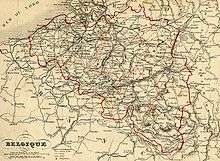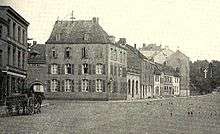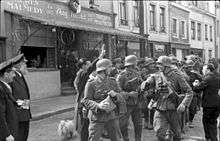Eupen-Malmedy
Eupen-Malmedy, Eupen-Malmédy or the East Cantons is a small, predominantly German-speaking region in eastern Belgium. It consists of three administrative cantons around the small cities of Eupen, Malmedy, and Sankt Vith which encompass some 730 square kilometres (280 sq mi). In the area itself, the region is referred to as East Belgium (German: Ostbelgien). Elsewhere in Belgium, the region is commonly referred to as the East Cantons (French: Cantons de l'Est, Dutch: Oostkantons).

Eupen-Malmedy became part of Belgium in the aftermath of World War I. The region, which had formerly been part of Prussia and the German Empire, was allocated to Belgium by the Treaty of Versailles. It was formally annexed after a controversial referendum in 1920, becoming part of the Province of Liège in 1925. Agitation by German nationalists during the interwar period led to its re-annexation by Nazi Germany during World War II. It was returned to Belgium in 1945. Today, it forms a large component of the German-speaking Community of Belgium, one of Belgium's three federal communities.
History
Background

Historically, the territories have little in common. The northern part around Eupen was originally part of the Duchy of Limburg,[1] a dependency of the Duchy of Brabant which was latterly part of the Austrian Netherlands. The Southern part, around Sankt Vith, belonged to the Duchy of Luxembourg.[1] The small village of Manderfeld-Schönberg belonged to the Archbishopric of Trier. Malmedy and Waimes, except the village of Faymonville, were part of the abbatial principality of Stavelot-Malmedy which was an Imperial Estate of the Holy Roman Empire. By the 19th century, the majority of the territory spoke German while the city of Malmedy was split between French and German speakers.[1]
In 1795, as the French Revolutionary Army entered the Austrian Netherlands, the area was also taken over and eventually incorporated in its entirety into the French department of the Ourthe.
Prussian administration, 1815–1919
At the Congress of Vienna, the whole area was awarded to the Kingdom of Prussia.[1] In the northwest of the area, Moresnet, coveted by both the Netherlands and Prussia for its calamine, was declared a neutral territory. After 1830, the 50 percent guardianship of the Netherlands was taken over by newly independent Belgium, and this remained so even after 1839, when Belgium relinquished its claims to neighbouring Dutch Limburg.

This change did not significantly affect the inhabitants of this region. Even in the mainly French or Walloon speaking Malmedy, changes went smoothly since the municipality was allowed to continue to use French for its administration until the Kulturkampf when the authorities forbade the use of French.
For instance, during a visit to the city in 1856, the King Frederick William IV is believed to have said "I am proud to have in my kingdom a little country where people speak French". For the people of Malmedy, this would eventually change when German was implemented as the only official administrative language. This was no problem in Eupen and St.Vith but more so in Malmedy-Waimes. There was some resistance to the interdiction: for instance, Roman Catholic priests who were forbidden to preach in French started to preach in Walloon in order to avoid having to preach in German.
Most of the territory had spoken German or German dialects for centuries, with Walloon being spoken by about two-thirds of the population in the district of Malmedy at the time it was newly created in 1816.[2] The overwhelmingly German-speaking district of Sankt Vith further south was, in 1821, united with the district of Malmedy to form a new, much larger district of Malmedy that then had a majority of German-speakers. According to the 1 December 1900 population census this new district of Malmedy had only a minority of 28.7% Walloon-speaking inhabitants. The smaller but more populous district of Eupen was almost entirely German-speaking, with Walloon and French speaking minorities making up less than 5 percent.[3] At the beginning of World War I, most of the inhabitants of the Eupen and Malmedy districts considered themselves German and fought for the German Empire during the war.
Provisional Belgian administration, 1919–25

During World War I, Belgium was invaded by the German Empire and, between 1914 and 1918, much of Belgium's territory was under German military occupation. With the defeat of Germany in 1918, Belgian politicians attempted to expand Belgian territory at German expense. However, the settlement at the Treaty of Versailles proved disappointing for Belgium.[4] Belgium failed to gain any territory from the Netherlands or Luxembourg, but was awarded the small German colonial territory of Ruanda-Urundi in Africa and Eupen-Malmedy in Europe, together with the previously neutral territory of Moresnet.[4] At the time, Eupen-Malmedy had approximately 64,000 residents.[4] Although the Belgian government attempted to depict Eupen-Malmedy as an ethnically Belgian territory, many Belgians were suspicious of the move.[4]
In 1919, a Transitional Government was established for Eupen-Malmedy by the Belgian government. It was headed by a Belgian general, Herman Baltia.[5] Under the terms of the Treaty, Belgian control over the territory was contingent on the result of a local plebiscite, held between January and June 1920. The plebiscite itself was held without a secret ballot, and organized as a consultation in which all citizens who opposed the annexation had to formally register their protest; just 271 of nearly 34,000 eligible voters did so.[6][7] The League of Nations accepted the result and the Transitional Government prepared for the unification of Eupen-Malmedy with Belgium in June 1925.[6]
Integration into Belgium, 1925–40
In June 1925, the Eupen-Malmedy was finally incorporated into the Belgian state as part of the Province of Liège. The inhabitants of the region voted in its first Belgian general election in 1925 and returned a vote in favour of the centre-right Catholic Party.[6] A local centre-right party, the Christliche Volkspartei (Christian People's Party), emerged by 1929.[8]
The early Belgian administration of Eupen-Malmedy was paralleled by secret negotiations between Belgian and Weimar German government of Gustav Stresemann over a possible return of the region in exchange for money.[9][10] The negotiations collapsed in 1926, following the German signature of the Locarno Treaties (1925) guaranteeing Germany's western borders and international pressure.
Various ethnic German organisations emerged in the Eupen-Malmedy region in the late 1920s, campaigning to promote German culture and the return of the territory to Germany.[11] After the rise to power of Adolf Hitler and the Nazi Party in Germany in 1933, agitation in Eupen-Malmedy increased and many inhabitants began to wear swastika badges.[8] Local socialists began to distance themselves from calls to return to Germany.[12] In 1935, an openly pro-Nazi party emerged locally, known as the Heimattreue Front, which achieved a majority in all three of the Eupen-Malmedy districts in the elections of 1936 and 1939.[13]
Annexed to Germany, 1940–45

In World War II, Nazi Germany invaded Belgium in May 1940 and rapidly defeated and occupied Belgium for a second time. On 18 May, Hitler announced the re-integration of Eupen-Malmedy into Germany while the rest of the country remained under military occupation.[14] The Belgian government in exile, however, refused to recognise the German annexation and maintained that Eupen-Malmedy was part of Belgium.[14] Administered as part of Nazi Germany, 8,000 local men were conscripted into the German armed forces of whom 2,200 were killed on the Eastern Front.[14][15] Support for the German takeover eroded sharply after the German invasion of the Soviet Union. The region suffered severely during the Ardennes Offensive of 1944–45 and Sankt Vith, in particular, was nearly totally destroyed by bombing.[15][16]
Return to Belgium, 1945–present
.jpg)
After the war, the Belgian state reasserted sovereignty over the area, which caused the male inhabitants of the area who had served in the German army to lose their civil rights as "traitors to the Belgian state". After the war, the Belgian authorities opened 16,400 investigations into citizens from Eupen-Malmedy, representing around 25 percent of the region's entire population. In comparison, the figure for the rest of Belgium represented less than five percent.[17][15]
After the war, demands to return Eupen-Malmedy to Germany faded. The first regionalist political party, the Partei der Deutschsprachigen Belgier (Party of German-speaking Belgians, or PDB), emerged in 1971 to argue that greater autonomy to be given to Belgium's German speakers within the newly created federal state but not for regional secession.[18] The PDB's campaign culminated in the creation of the German-speaking Community of Belgium in 1984 which provided cultural autonomy to Belgium's 70,000 German speakers along the same lines as those already negotiated for Belgium's Dutch and French-speaking communities.[15] The nine German-speaking communes of the East Cantons form part of the German-speaking Community while Malmedy and Waimes are part of the French Community. There are protected rights for the minority language in both areas.
Languages spoken in the area

The linguistic situation of the wider area is complex since it lies on the border between the Romance and Germanic languages and on an isogloss dividing several German dialects. In general, over the past decades, the local dialects have lost ground to German and French.
Historically, in Aubel, Baelen, Plombières, Welkenraedt (neighbouring Belgian municipalities), Eupen, Kelmis and Lontzen, the local languages have been classed as Limburgish, thus dialects of Low Franconian or Dutch. The inhabitants of Raeren have spoken Ripuarian and those of the district of Sankt Vith Moselle Franconian, which are dialects of High German. On the other hand, most of the people living in Malmedy and Waimes speak Walloon or French, with a minority of German speakers. Some of the folklore and carnival traditions there are still in the Walloon language. That is also the case for the children:
"The New Year's wishes have hardly been uttered when the children start going round from house to house in order to celebrate the three kings. The individual groups sing a song at the doors and demand a “lôtire” for their efforts, in other words a small sweetmeat. They sing in Walloon and say that the kings have sent them."[19]
The East Cantons as a whole should therefore not be confused with the German language region created in 1963 or with the German-speaking Community of Belgium, which does not include the (smaller) Malmedy and Waimes areas.
Current administration
After becoming part of Belgium in the 1920s, the municipalities composing these territories were grouped into the three cantons of Eupen, Malmedy, and Sankt Vith. The administration was overhauled during the local government reforms of 1976–77, and are now administered as follows:
- Eupen: Eupen and Kettenis
- Kelmis (in French La Calamine): Kelmis, Neu-Moresnet and Hergenrath
- Moresnet: Lontzen and Walhorn
- Raeren: Raeren, Eynatten and Hauset
- Sankt Vith (in French Saint-Vith): Sankt Vith, Crombach, Lommersweiler, Schönberg and Recht
- Bütgenbach (in French Butgenbach): Bütgenbach and Elsenborn
- Büllingen (in French Bullange): Büllingen, Manderfeld and Rocherath
- Amel (in French Amblève): Amel, Heppenbach and Meyerode
- Burg-Reuland: Reuland and Thommen
- Canton of Malmedy
- Malmedy: Malmedy, Bévercé and Bellevaux-Ligneuville
- Waimes (in German Weismes): Waimes, Faymonville and Robertville
Linguistically, the Canton of Malmedy is mostly Francophone while the Cantons of Eupen and Sankt Vith are mostly Germanophone. When the three language-based communities of Belgium were created as part of the Belgian state reforms, Malmedy was placed in the French-speaking Community and Eupen and Sankt Vith were placed in the German-speaking Community. All the 11 municipalities of the East Cantons are "municipalities with language facilities", with the nine Germanophone municipalities also offering services in French and the two Francophone municipalities also offering services in German.
See also
- Areas annexed by Nazi Germany
- Belgian annexation plans after the Second World War
- German-speaking Community of Belgium
- Low Dietsch
- Principality of Stavelot-Malmedy
References
- Dewulf 2009, p. 70.
- Hahn, Hans-Henning and Kunze, Peter: Nationale Minderheiten und staatliche Minderheitenpolitik in Deutschland im 19. Jahrhundert. Akademie Verlag GmbH, Berlin, 1999 (German)
- 'Foreign-language minorities in the German Reich according to the population census of 1 December 1900 (German) Archived 14 April 2011 at the Wayback Machine
- O'Connell 2013, p. 12.
- O'Connell 2013, p. 13.
- O'Connell 2013, p. 15.
- Dewulf 2009, p. 71.
- O'Connell 2013, p. 34.
- O'Connell 2013, pp. 18-23.
- Grathwol 1975, pp. 221-50.
- O'Connell 2013, pp. 33-4.
- O'Connell 2013, p. 39.
- O'Connell 2013, pp. 40-1.
- O'Connell 2013, p. 41.
- Cook 2004, p. 143.
- Dewulf 2009, p. 72.
- O'Connell 2013, p. 43.
- Dewulf 2009, p. 73.
- 'The Feast of Epiphany
Bibliography
- Cook, Bernard A. (2004). Belgium: A History. New York: Peter Lang. ISBN 978-0-8204-5824-3.CS1 maint: ref=harv (link)
- O'Connell, Vincent (2013). ""Left to Their Own Devices". Belgium's Ambiguous Assimilation of Eupen-Malmedy (1919-1940)" (PDF). Journal of Belgian History. 43 (4): 10–45.CS1 maint: ref=harv (link)
- Grathwol, Robert P. (1975). "Germany and the Eupen-Malmédy Affair, 1924-26: "Here Lies the Spirit of Locarno"". Central European History. 8 (3): 221–50. doi:10.1017/s0008938900017921. JSTOR 4545745.CS1 maint: ref=harv (link)
- Dewulf, Jeroen (2009). ""O liebes Land", "o Belgiens Erde": The Development of the German-Speaking Community in Belgium Reflected in the Light of the Flemish Struggle for Autonomy". German Studies Review. 32 (1): 65–81. JSTOR 27668656.CS1 maint: ref=harv (link)
Further reading
- O'Connell, Vincent (2011). "Dictating Democracy: the Impact of Governor Baltia's Transitory Regime on Local Government In Eupen-Malmedy, 1919-1922-1925". The International Journal of Regional and Local Studies. 7 (1–2): 162–87. doi:10.1179/jrl.2011.7.1-2.162.
- Enssle, Manfred J. (1980). Stresemann's Territorial Revisionism: Germany, Belgium, and the Eupen-Malmédy Question, 1919-1929. Wiesbaden: Steiner. ISBN 9783515029599.
- O'Connell, Vincent (2018). The annexation of Eupen-Malmedy : becoming Belgian, 1919-1929. New York: Palgrave Macmillan. ISBN 978-1-137-59089-3.
External links
- Wie erfahren die Bewohner der deutschsprachigen Gemeinschaft ihre Identität und das politische Autonomiebestreben? (Thesis)
- Homepage at the Parlament der Deutschsprachingen Gemeinschaft